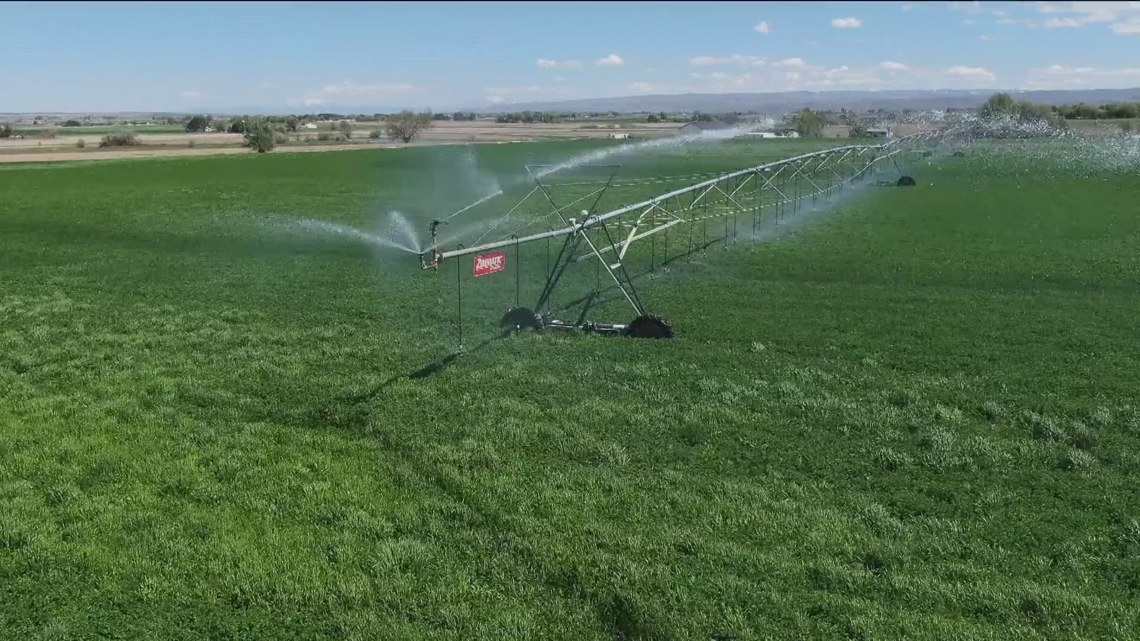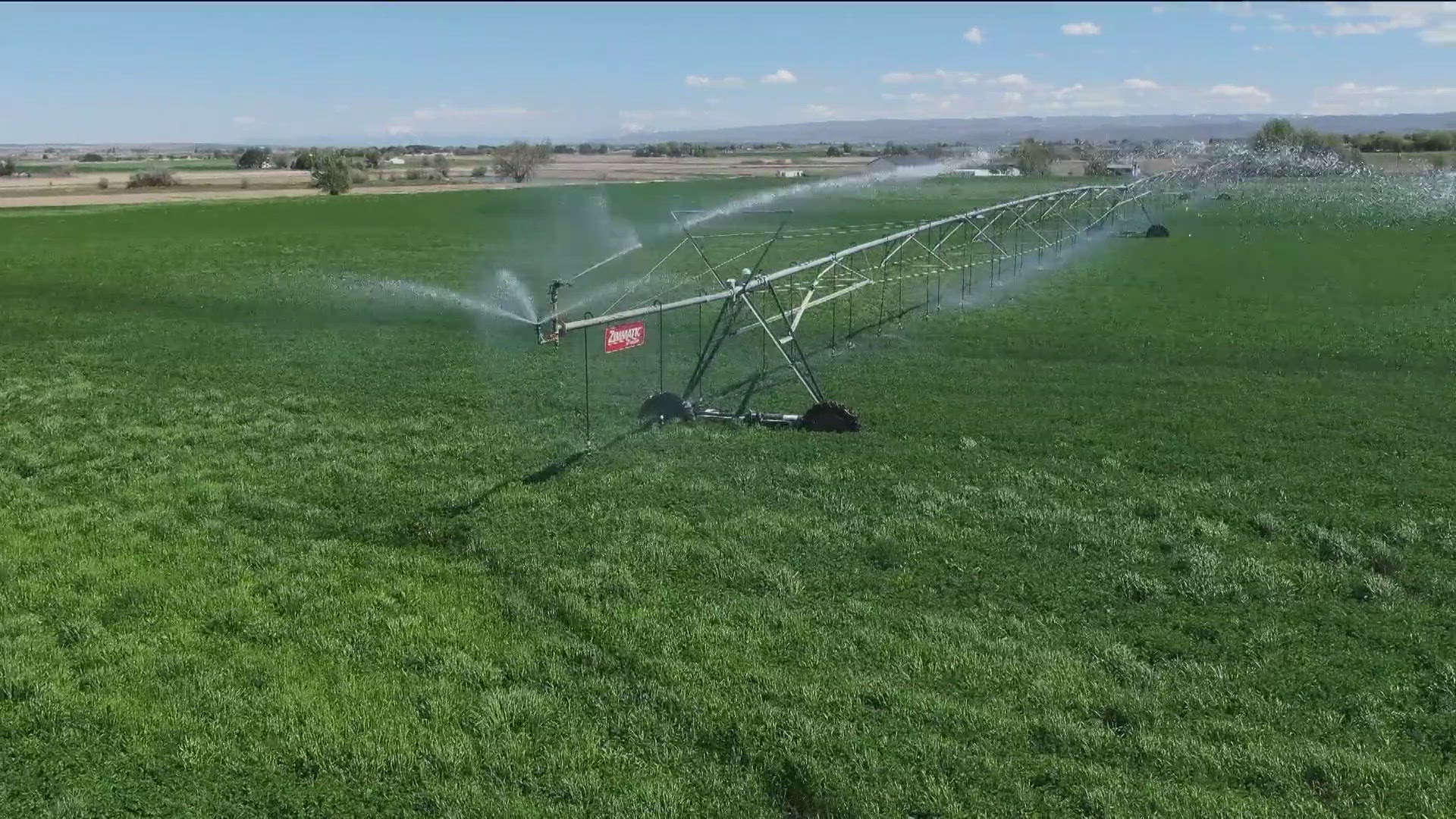BOISE, Idaho — It's a question, or a series of them rather, that has hung over farmers in Idaho for decades: What to do about Idaho's complicated water rights?
In the Gem State, water rights essentially operate under a "first come, first served" method; in which there are two categories, the surface water users and the groundwater users.
The surface water users generally rely on canals for water, and they typically come from a long legacy of users called "senior water rights" holders. Then there are the groundwater users, who have to go underground to access water, from resources such as an aquifer. These users are generally the new kids on the rural block, and they're dubbed "junior water rights" holders.
The Department of Water Resources is legally permitted to shut off Idahoans' access to water if they are not in compliance with an eight-year-old, state-wide agreement, leaving groundwater users at the center of a dust-up with some farmers facing curtailment, or a water shut-off, from state water managers.


As negotiations continue in an effort to avoid a water curtailment, groundwater users in portions of Idaho remain in limbo.
“It would absolutely be devastating, it would it put us under,” said Adam Young, a farmer from Blackfoot, Idaho.
Young is a third-generation farmer. He said his family farm has been in business for 70 years; however, he now fears a curtailment, or the shutting down of water, could bring it to extinction.
For now, Young continues his daily work but knows there is a shutoff looming. He, too, received a curtailment order.
“Well, I mean, effectively, we don't really have any other choice because to say we're going to put an end to our season right now is to say we're going to put an end to our farm permanently,” Young said.
There is a longstanding conflict between surface water users who tend to have more senior water rights and groundwater users with junior rights. The major conflict now is over rights to the Eastern Snake Plain Aquifer.
The groundwater users having their water cut off argue that they are in dire straits. But there are laws protecting the senior rights of surface water users.
As Idaho follows the prior appropriation doctrine of "first in time, first in rights" for water rights, senior priority water rights get their water fulfilled first, and the juniors get the remainder. If there is not enough water to fill all water rights, junior users can then potentially be curtailed.
The problem derives from the decline in spring flows and water levels in the Eastern Snake Plain Aquifer, which has been dropping since the 1950s as groundwater pumping for irrigation increased.
The issues between surface and groundwater users created a methodology to determine material injury (or impact) to senior water users.
The methodology has been in practice for several years to evaluate water supply and crop need in order to then determine the magnitude of impact to senior water users.
In 2016, an agreement was finalized between surface water and groundwater groups. It required groundwater reductions of 240,000 acre-feet per year, or 13% across the region, by groundwater districts.
But now, some groundwater districts are looking to follow an older 2009 mitigation plan involving delivery of storage water to the surface water coalition instead, and the groups are disputing over how it is all calculated.
“Immediately we want to solve the curtailment,” said TJ Budge, general counsel for Idaho Groundwater Appropriators (IGWA).
“It's really a philosophical disagreement as to how the state should manage its resource," Budge explained. "We're in an era of diminishing water supplies from climate change and other factors, and we want to continue to sustain our economy. And there's a difference as to how we do that most effectively.”
A mitigation plan was most recently drafted in 2015 and put into action the following year. Groundwater users share a perspective that the plan is now outdated and needing change regarding how senior rights are measured and reflected in mitigation efforts.
“We have to use modern technology, to manage the resource better. We had to become more efficient in how we use the resource. So, we think there's a lot of things that can be done that are better for the public, better for the state. Keeps the seniors in business,” Budge said. “We understand that they need to be able to irrigate their crops. We think we can do that in a way that keeps a lot more farmland in production.”
The Idaho Department of Water Resources informed groundwater users that mitigation was needed for the 2024 season, it pairs with the 2016 state plan that requires groundwater reductions of 240,000 acre-feet per year. There are critics of the groundwater users who point out the laws and regulations are what they are, and there is a violation happening whether you like the existing system or not. A point from groundwater users is they believe the calculations from the 2016 agreement are off.
“We know more about how the aquifer works and how it interacts with the river. Some of the assumptions that went into the 2015 agreement didn't hold true, and we've got to respond to that. So, we have new and better data, and we've got to respond to that and figure out how to manage our resource most effectively to meet the water needs of the seniors in a way that keeps farmland and in production. And that's our mission,” Budge said.
Farmers understand that a collective effort is needed to solve the problem.
“It has never been the position of any of us that. That we do not have any obligation either to the aquifer or to ensure that senior water holders are not harmed by shortages. We understand that we are junior. We understand that we need to be able to work together to come up with solutions that can ensure water supply to farmers with senior water rights,” Young said. "But we also need to do that in a way that doesn't put half of the state out of business.”
The timing of the curtailment order is also a point of contention. There is an understanding of the laws and authority from state officials, but in reality, it isn’t feasible according to the groundwater camp.
“I mean, you can't do that without losing everything. The timing of it is terrible,” Young said.
“We understand prior appropriation. We understand that the seniors need to have enough water to irrigate their crops. How we go about achieving that? There's more than one way to do it. And that's the heart of the conflict. We don't think escalating dry-ups are the right way to do it,” Budge said.
For now, complicated negotiations continue. There is optimism a short-term solution is close, there is also commitment to creating a lasting one.
“We've had assurance from the governor and other leaders of the state that they recognize the 2016 agreement is showing its age. It's no longer workable," Budge concluded. "We've got to come up with a better path forward. And so, we're going to take them at their word, and we're doing our best to try to solve 24 with a process to change course. Going forward, we cannot be here next year.”
Join 'The 208' conversation:
- Text us at (208) 321-5614
- E-mail us at the208@ktvb.com
- Join our The 208 Facebook group: https://www.facebook.com/groups/the208KTVB/
- Follow us on Twitter: @the208KTVB or tweet #the208 and #SoIdaho
- Follow us on Instagram: @the208KTVB
- Bookmark our landing page: /the-208
- Still reading this list? We're on YouTube, too:
HERE ARE MORE WAYS TO GET NEWS FROM KTVB:
Download the KTVB News Mobile App
Apple iOS: Click here to download
Google Play: Click here to download
Watch news reports for FREE on YouTube: KTVB YouTube channel
Stream Live for FREE on ROKU: Add the channel from the ROKU store or by searching 'KTVB'.
Stream Live for FREE on FIRE TV: Search ‘KTVB’ and click ‘Get’ to download.


